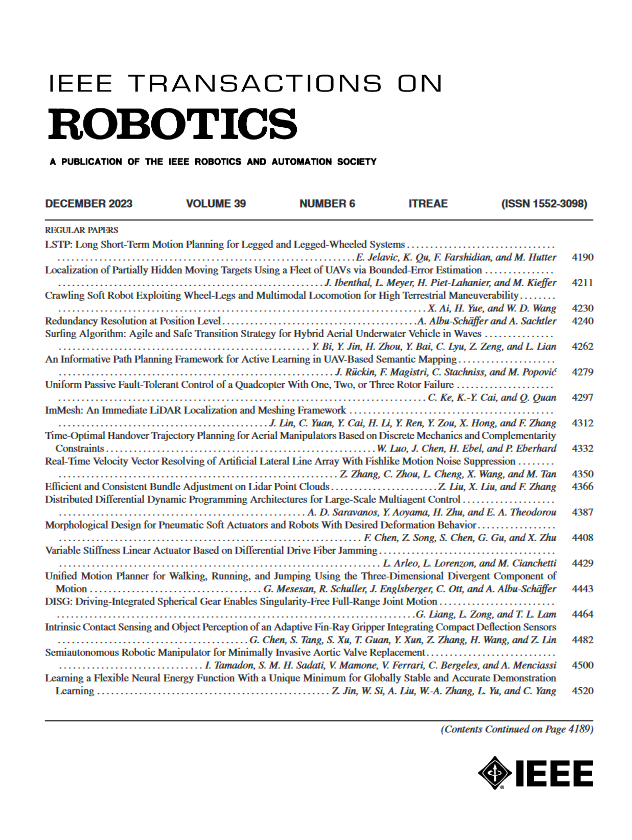A Unilateral Active Knee Exoskeleton to Assist Individuals With Hemiparesis—A Pilot Study
IF 10.5
1区 计算机科学
Q1 ROBOTICS
引用次数: 0
Abstract
Most individuals who experience a stroke exhibit several sensorimotor impairments that limit their independence in everyday activities. Hemiparetic gait is frequently characterized by reduced knee flexion in swing due to knee stiffness or muscle weakness and knee hyperextension or knee buckling in the stance phase. Recently, unilateral-powered orthoses have been designed to overcome the limitations of the passive knee–ankle–foot orthoses. This study presents a unilateral active knee orthosis exoskeleton, AKO-β, endowed with a series-elastic actuator and designed to assist the knee in flexion and extension movements. In this article, we describe the system mechatronic design and its characterization on the bench, the control system, and pilot experiments with three poststroke participants. The device has a weight of 1.78 kg on the user’s leg, with a lateral encumbrance of 76 mm. The pilot experiments aimed to verify the effects of the exoskeleton assistance in hemiparetic gait patterns. When walking with the device, participants on average increased the knee flexion on the paretic side by 18.70° (+44.9%) during swing and decreased knee hyperextension in stance by 4.50°, compared to walking without it. Overall, when walking with the exoskeleton, subjects showed an improved gait variable score of the paretic knee profile by 37.5% compared to walking without it. The temporal and spatial gait symmetry indices did not show clear changes, although an improvement in symmetry was observed in two of the three participants. These preliminary results suggest the potential benefits of the unilateral active knee orthosis exoskeleton to enhance and restore mobility in individuals with hemiparetic gait.单侧活动膝关节外骨骼辅助偏瘫患者的初步研究
大多数中风患者表现出几种感觉运动障碍,限制了他们在日常活动中的独立性。偏瘫步态的常见特征是由于膝关节僵硬或肌肉无力导致摆动时膝关节屈曲减少,站立时膝关节过伸或膝关节屈曲。最近,单侧动力矫形器被设计用来克服被动膝-踝-足矫形器的局限性。本研究提出了一种单侧主动膝关节矫形外骨骼AKO-β,具有系列弹性致动器,旨在帮助膝关节屈伸运动。在本文中,我们描述了系统的机电一体化设计及其在台架上的表征,控制系统,以及三名中风后参与者的中试实验。该装置在使用者腿上的重量为1.78公斤,横向负担为76毫米。试点实验旨在验证外骨骼辅助偏瘫步态模式的效果。与不带该装置行走相比,带该装置行走时,参与者在摆动时平均使麻痹侧膝关节屈曲度增加18.70°(+44.9%),在站立时膝关节过伸度减少4.50°。总体而言,与不带外骨骼行走相比,带外骨骼行走时,受试者的步态变量评分(partic knee profile)改善了37.5%。时间和空间步态对称指数没有显示出明显的变化,尽管三名参与者中有两人的对称性有所改善。这些初步结果表明单侧主动膝关节矫形器外骨骼在增强和恢复偏瘫步态患者的活动能力方面的潜在益处。
本文章由计算机程序翻译,如有差异,请以英文原文为准。
求助全文
约1分钟内获得全文
求助全文
来源期刊

IEEE Transactions on Robotics
工程技术-机器人学
CiteScore
14.90
自引率
5.10%
发文量
259
审稿时长
6.0 months
期刊介绍:
The IEEE Transactions on Robotics (T-RO) is dedicated to publishing fundamental papers covering all facets of robotics, drawing on interdisciplinary approaches from computer science, control systems, electrical engineering, mathematics, mechanical engineering, and beyond. From industrial applications to service and personal assistants, surgical operations to space, underwater, and remote exploration, robots and intelligent machines play pivotal roles across various domains, including entertainment, safety, search and rescue, military applications, agriculture, and intelligent vehicles.
Special emphasis is placed on intelligent machines and systems designed for unstructured environments, where a significant portion of the environment remains unknown and beyond direct sensing or control.
 求助内容:
求助内容: 应助结果提醒方式:
应助结果提醒方式:


